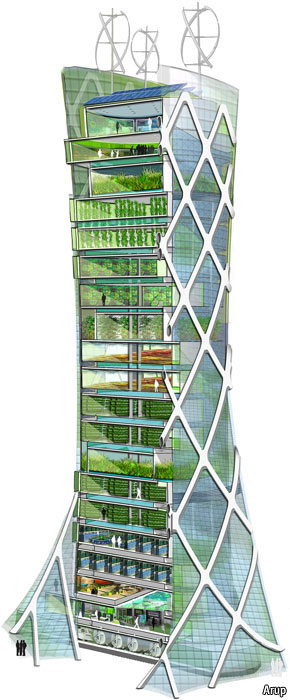Is the next “green revolution” going to happen in cities?
There are two main reasons that explain the increased interest in urban agriculture in the recent years. One of them is the increasing concerns about health and environmental impacts of large-scale industrial agriculture. On the other hand, urban agriculture is growing because it is becoming a necessary step for the adaptation to climate change and a necessary measure for food security. Projects of urban agriculture are happening in developed as well as developing world because they offer an alternative for jobs and growth (Kenya’s example).
In the United States, urban agriculture can have different forms. The most creative I’ve read about is the “vertical farm” project, which is based on hydroponic methods of cultivation. Hydroponics is a method of growing plants using mineral nutrient solutions in water, without soil.
As urban population grows and deforestation increases as a consequence of the agricultural expansion, hydroponics is an attractive alternative. It offers two main advantages. The first is that it doesn’t require soil –therefore it decreases the incentives for agricultural expansion- and the second is that it the greenhouse must maintain the same temperature throughout the year -which can help stabilize food production in a climate-changing world. The technology reduces land requirements for crops by 75% or more, and water use by 90%. Crop nutrients are contained and recycled so no residual salts are lost to environment. Herbicide use is non-existent and pesticides required are natural vegetable sprays and barriers (see reference).
Microbiologist Dr. Dickson Despommier, from Columbia University, is one of the main developers and promoters of the idea of “vertical farms”. Vertical farms don’t exist yet because the initial investment is really high (designing the building, bringing the new technologies and maintaining the vertical farm is very expensive). Despommier estimates that a farm would cost from $20 million to $30 million but there is no official research on the subject yet (his estimation is probably lower than the real cost).
Supporters of hydroponic vertical farming claim that the benefits of vertical farming on the environment and on the economy will be very significant. An advantage of vertical farms is that they reduce transportation costs of food and decrease pollution. But the reduction of transportation costs is not likely to offset the pollution and the cost that a vertical farm would require. Indeed, maintaining favorable temperatures and light conditions throughout the year is likely to emit large quantities of greenhouse gases.
Another advantage that supporters of hydroponic vertical farming claim is that by centralizing agricultural production there will be less demand for agricultural land. The rainforests and natural ecosystems that are being cleared for agriculture will be able to stop and ecosystems will be restored. However, because in the U. S the largest part of the agricultural land is dedicated to massive production of a few crops, vertical farming would give no competition to these large agricultural productions and it could not significantly reduce deforestation in developed or developing nations.
Hydroponic gardening could be a really useful tool to increase food security because it doesn’t depend on the climate conditions. Furthermore, it only uses water and plastic. I think that the importance of hydroponic gardening will only increase as the climate change worsens agricultural production. If the fertility of the soils and the climate temperatures change in very radical ways, hydroponic agriculture will become the best available option.
The vertical farm project is an interesting example of alternative forms of agriculture. As discussed above, the vertical farm project could represent some advantages to the environment but they are being overstated (such as reduction of transportation costs and deforestation) because it is neglecting the larger problems of our food system. The positive impacts of vertical farming will depend on what is happening outside the cities too, in the rural agricultural areas. If most of our land is still cultivated in unsustainable ways, the positive impact of vertical farms will not be as important. Even though our technological knowledge will allow us to become less dependent on climate variability, in order to have larger benefits from urban farms it is important to focus on what is happening in the whole of the food system.
Julia Naime (@julianasah) is a research intern at the SISGI Group. She is a senior at New York University majoring in Economics. During her internship, she is researching rural and international development and environmental policies. To learn more about the SISGI Group, please visit www.sisgigroup.org.


